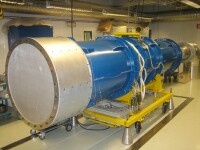AETR- Aeroelasticity Test Rig
AETR is a test facility for experimentally investigating aerodynamic damping in turbomachines. Aerodynamic damping is one of the ingredients in aeroelasticity and is of interest as it can lead to instability (flutter). AETR has been commissioned in 2003 and is world-unique as it allows studying the aeroelastic phenomena at relevant operating parameters while providing a great experimental freedom.

The AETR facility is run in continuous mode and is connected to a large-scale air supply system. The test section is of annular sector shape with varying number of blades. At present there are test objects comprising 5 or 7 turbine blades. One of the blades in the sector can be made oscillating in various modes. The mode is a rigid-body oscillation around a pivot point placed in the blade root. During blade oscillation the unsteady blade surface pressure is measured on several blades by means of fast-respone pressure instrumentation. The time-varying pressure is then reduced to a complex value giving information on the aerodynamic damping.
The test facility provides a great variability of operating parameters. The following parameters can be varied, many of those continuously:
- Pressure ratio
- Flow velocity
- Inlet flow angle
- Total temperature
- Oscillation mode (bending, torsion, combined bending and torsion)
- Oscillation frequency
- Tip clearance
The stationary flow field in the facility is controlled by means of flexible sidewalls such as to achieve periodicity. This is necessary as the otherwise inherently present periodicity is not present in a sector facility.

The challenge in the present case was to have a system that works in the annular environment. The AETR facility is the only facility that features such a system working in place.
In addition to the stationary periodicity it is essential to ensure the unsteady periodicity, i.e. the similarity of the unsteady flow when having the oscillating blade positioned at various indices. The unsteady periodicity has been assessed extensively in the present facility and has been found to be of good quality.
The AETR facility is equipped with various measurement techniques for investigating the flow penomena of interest. At present the following experimental possibilities are given:
- Stationary pressure measurements
- Measurement of flow temperature
- Aerodynamic probe measurements (up- and downstream)
- Unsteady pressure measurements
- Flow visualization (on surfaces as well in flow field)
- Laser velocimetry (LDA, 3D-L2F)
- Laser vibrometry of blade oscillation
